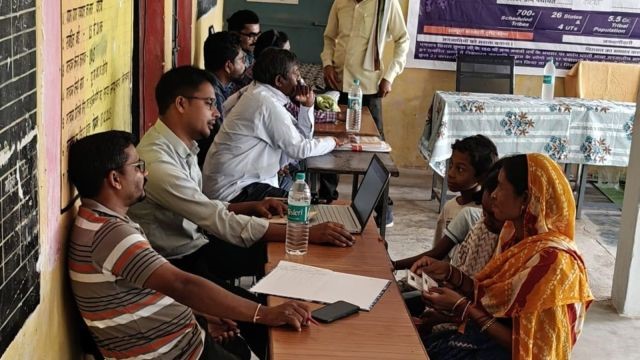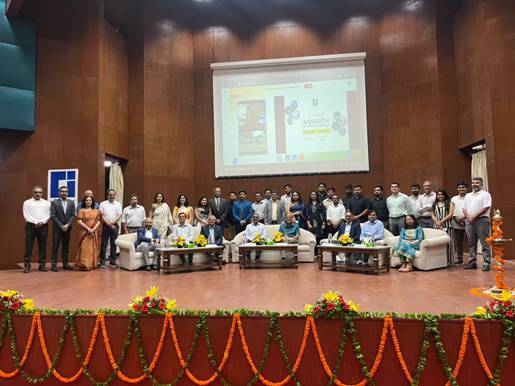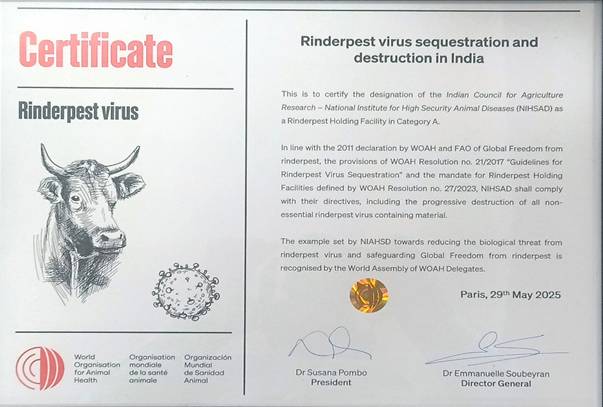PM-JANMAN and Dharti Aaba Initiatives

- 19 Jun 2025
In News:
- The Ministry of Tribal Affairs has launched a nationwide outreach campaign targeting over 500 districts and 1 lakh tribal-dominated villages and habitations.
- The campaign aims to ensure benefit saturation and last-mile delivery of welfare schemes under the Pradhan Mantri Janjati Adivasi Nyaya Maha Abhiyan (PM-JANMAN) and the Dharti Aaba Janjatiya Gram Utkarsh Abhiyan.
- This initiative is part of the ongoing Janjatiya Gaurav Varsh (Tribal Pride Year), a year-long celebration started on November 15, 2024 — the birth anniversary of Birsa Munda, a revered anti-colonial tribal icon.
Pradhan Mantri Janjati Adivasi Nyaya Maha Abhiyan (PM-JANMAN)
- Launched: 2023 on Janjatiya Gaurav Diwas
- Focus: Holistic development of Particularly Vulnerable Tribal Groups (PVTGs)
- Type: Includes both Central Sector and Centrally Sponsored Schemes
- Objectives:
- Safe housing (via PMAY)
- Clean drinking water
- Health, nutrition, and education access
- Road and telecom connectivity
- Electrification of unelectrified households
- Sustainable livelihood opportunities
- Time Frame: 3-year targeted implementation
- Vision: Supports Viksit Gaon, Viksit Bharat, and inclusive development with social justice
Dharti Aaba Janjatiya Gram Utkarsh Abhiyan
- Launched: October 2, 2024, by PM Modi in Jharkhand
- Named After: Birsa Munda, also known as Dharti Aaba (Father of the Earth)
- Aim: Transform tribal villages into centres of opportunity and dignity
- Approach:
- Multi-sectoral convergence with 17 line ministries
- 25 targeted interventions for integrated rural development
- Welfare activities include: hostel construction, rural electrification, livestock and fisheries support, housing under PMAY, etc.
- Budget Allocation (Union Budget 2025–26):
- Total: ?79,156 crore over 5 years
- Central Share: ?56,333 crore
- State Share: ?22,823 crore
Outreach Campaign (June 2025) Highlights
- Duration: Fortnight-long outreach starting June 15, 2025
- Coverage: 1 lakh tribal villages and habitations across 500+ districts
- Services at Doorstep:
- Aadhaar and Ayushman Bharat card enrollment
- Forest Rights Act (FRA) land title distribution
- Opening of pension and Jan Dhan accounts
- Goal: Awareness generation and saturation of benefits at block and hamlet levels
- Strategy: On-ground ‘benefit saturation camps’ to popularize uptake of the schemes
Significance
- Focus on PVTGs, who are the most marginalized among tribal communities
- Promotes digital inclusion, financial inclusion, and documentation access
- Demonstrates convergent governance through coordination across ministries
- Reinforces India’s tribal empowerment narrative and acknowledges historical contributions through Birsa Munda's legacy
‘Samarth’ Incubation Program

- 19 Jun 2025
In News:
The Centre for Development of Telematics (C-DOT), an autonomous R&D institution under the Department of Telecommunications (DoT), Government of India, has launched ‘Samarth’, a cutting-edge incubation program for startups in the Telecom and ICT sectors. In June 2025, C-DOT formally initiated Cohort-I of the program, selecting 18 startups through a competitive national process.
About the Samarth Program
- Objective: To nurture sustainable and scalable startups from ideation to commercialization in high-tech domains.
- Focus Areas:
- Telecom applications
- Cybersecurity
- 5G/6G technologies
- Artificial Intelligence (AI)
- Internet of Things (IoT)
- Quantum technologies
Key Features
Feature Details
Financial Support Grant of up to ?5 lakh per startup
Infrastructure Fully furnished office space at C-DOT campuses in Delhi and Bengaluru for 6 months
Technical Access Use of C-DOT’s lab facilities
Mentorship Guidance from C-DOT technologists and external domain experts
Format Hybrid (online + physical) delivery
Program Structure Two cohorts per year, each supporting up to 18 startups (max 36 annually)
Further Opportunities Eligible for extended collaboration and funding under C-DOT Collaborative Research Program (CCRP)
Implementation and Partnerships
- Implementation Partners:
- Software Technology Parks of India (STPI)
- TiE (The Indus Entrepreneurs) – Delhi NCR Chapter
- Evaluation Criteria: Startups were selected based on innovation, team strength, execution capability, problem-solution relevance, and commercialization potential.
- A distinguished Selection Committee from academia, industry, and government oversaw the evaluation.
Significance
- Boosts indigenous R&D in critical emerging tech sectors aligned with national priorities.
- Supports Atmanirbhar Bharat by encouraging homegrown innovation.
- Builds a robust startup ecosystem in the strategic telecom and ICT domains.
- Encourages public-private partnerships and collaboration between startups and research institutions.
Grand Cross of the Order of Makarios III
- 19 Jun 2025
In News:
During his official visit to Cyprus, Prime Minister Narendra Modi was conferred the Grand Cross of the Order of Makarios III, the highest civilian honour of Cyprus. This visit marked the first-ever visit by an Indian Prime Minister to the Mediterranean island nation.
About the Order of Makarios III
- Institution: Established in 1991.
- Named After: Archbishop Makarios III, the first President of the Republic of Cyprus.
- Nature: Cyprus’s highest merit-based honour, awarded to heads of state and individuals of significant global stature.
- Awarded By: The President of Cyprus.
- Grades:
- Grand Collar (highest)
- Grand Cross
- Grand Commander
- Commander
- Officer
- Knight
PM Modi received the Grand Cross, making him one of the few global leaders to be honoured at this level. The Prime Minister dedicated the award to the friendship between India and Cyprus, highlighting shared values and diplomatic ties.
Diplomatic and Economic Significance
- A roundtable interaction with top CEOs from both nations was held, focusing on deepening commercial and strategic engagement.
- Key sectors discussed:
- Innovation
- Energy
- Technology
- Trade and Investment
- PM Modi highlighted India's reform trajectory over the last decade, reinforcing India’s position as a growing economic partner.
Cyprus acknowledged this partnership, stating it was entering a "new era of strategic cooperation" with India, rooted in trust, shared values, and innovation.
Geographical Snapshot: Cyprus
- Region: Eastern Mediterranean
- Status: Eurasian island nation
- Capital: Nicosia
- Major Cities: Limassol, Larnaca, Famagusta, Paphos
- Highest Point: Mount Olympus (1,952 m)
- Size: Third-largest Mediterranean island after Sicily and Sardinia
Rinderpest

- 19 Jun 2025
In News:
- India has been officially designated as a Category A Rinderpest Holding Facility (RHF) by the World Organisation for Animal Health (WOAH) and the Food and Agriculture Organization (FAO).
- The recognition was conferred to the ICAR-National Institute of High Security Animal Diseases (NIHSAD) in Bhopal during the 92nd General Session of WOAH held in Paris.
- This makes India one of only six countries globally entrusted with this vital responsibility, marking a major milestone in India’s global leadership in animal health and biosecurity.
What is Rinderpest?
- Also Known As: Cattle Plague
- Pathogen: Caused by a virus from the Paramyxoviridae family, genus Morbillivirus.
- Affected Species: Mainly cattle and buffalo, but also zebus, giraffes, eland, wildebeest, warthogs, and some antelope species.
- Symptoms in Cattle:
- High fever, nasal and eye discharge
- Erosive mouth lesions
- Severe diarrhoea and dehydration
- Death typically within 10–15 days in susceptible herds
- Transmission: Through direct contact; virus present in nasal secretions even before clinical symptoms appear.
- Public Health Risk: None – the virus does not affect humans.
- Geographical Spread: Historically affected Europe, Africa, and Asia.
- Eradication: Officially declared eradicated in 2011, making it the second disease in history to be eradicated after smallpox.
Significance of the Category A RHF Designation
- Background:
- Despite eradication, Rinderpest Virus-Containing Material (RVCM) remains in select laboratories.
- FAO and WOAH limit storage of RVCM to ensure global biosecurity and prevent accidental or intentional release.
- India’s Preparedness:
- In 2012, ICAR-NIHSAD was designated as India’s national repository for RVCM.
- It is a Biosafety Level-3 (BSL-3) facility and a WOAH reference laboratory for avian influenza.
- Recent Developments:
- India submitted its RHF application in 2019.
- In March 2025, FAO-WOAH appointed international experts to inspect the facility.
- Based on strong biosafety, inventory control, and emergency preparedness, ICAR-NIHSAD has now received Category A RHF status for one year.
Implications for India
- Global Recognition: Reinforces India’s commitment to the One Health framework and global biosecurity norms.
- Leadership Role: Positions India among a select global group of only six RHFs, enabling it to contribute to future efforts in disease surveillance, vaccine research, and emergency preparedness.
- Future Prospects:
- Encouraged by WOAH-FAO to contribute to vaccine seed material discussions.
- Paves the way for Category B designation, which allows broader collaborative work on RVCM.
Synthetic Aperture Radar (SAR)

- 19 Jun 2025
In News:
Recently, NASA said the NASA-ISRO SAR mission had arrived at ISRO’s spaceport in Sriharikota
What is Synthetic Aperture Radar (SAR)?
Synthetic Aperture Radar (SAR) is an advanced remote sensing technology used to generate high-resolution images of Earth's surface, irrespective of weather or lighting conditions.
- Unlike optical sensors that rely on visible light, SAR systems emit microwave pulses and measure the reflected signals (echoes) from the ground, ocean, ice, or structures.
- These echoes are then processed to create detailed images using advanced signal processing techniques.
How SAR Works
- Antenna System: Traditionally, larger antennas yield better resolution, but they are impractical for satellites. SAR overcomes this by using a small antenna mounted on a moving platform (like a satellite), capturing echoes from different positions.
- Through precise timing and phase information, the system simulates a much larger "synthetic" antenna, enhancing image resolution without the need for large hardware.
Advantages of SAR
- All-Weather, All-Time Imaging: SAR can operate day and night and penetrate clouds, smoke, and light rain, ensuring uninterrupted data collection.
- Material Differentiation: Various materials (soil, water, vegetation, buildings) reflect microwaves differently, enabling SAR to detect subtle changes not visible through optical imagery.
- Large Area Mapping: Mounted on satellites, SAR can map swaths of land hundreds of kilometres wide in a single pass.
NASA-ISRO SAR (NISAR) Mission
- Joint Collaboration: A flagship Earth-observing mission between NASA and ISRO.
- On June 12, 2025, NASA confirmed that the NISAR satellite had arrived at ISRO’s spaceport in Sriharikota for its scheduled launch.
Mission Objectives
- NISAR will map nearly all of Earth's land and ice surfaces twice every 12 days.
- It aims to provide unprecedented data on Earth’s environment, including:
- Ecosystem disturbances
- Land use changes
- Ice sheet dynamics
- Natural disasters (earthquakes, landslides, floods)
Significance
- Will support climate change monitoring, disaster response, and agricultural planning.
- It represents a major step in India’s and the U.S.'s scientific diplomacy and technological cooperation.
